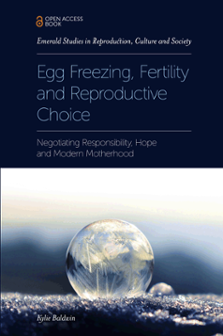
Appendix 3: Glossary of Terms
Egg Freezing, Fertility and Reproductive Choice
ISBN: 978-1-78756-484-8, eISBN: 978-1-78756-483-1
Publication date: 5 September 2019
Citation
Baldwin, K. (2019), "Appendix 3: Glossary of Terms", Egg Freezing, Fertility and Reproductive Choice (Emerald Studies in Reproduction, Culture and Society), Emerald Publishing Limited, Leeds, pp. 161-162. https://doi.org/10.1108/978-1-78756-483-120191014
Publisher
:Emerald Publishing Limited
Copyright © 2019, Kylie Baldwin
License
Except where otherwise noted, this work is licensed under a Creative Commons Attribution 4.0 Licence (CC BY 4.0). Anyone may reproduce, distribute, translate and create derivative works of this book (for both commercial and non-commercial purposes), subject to full attribution to the original publication and authors. The full terms of this licence may be seen at https://creativecommons.org/licenses/by/4.0/
- Follicle-stimulating hormone:
-
Hormone produced by the pituitary gland which stimulates the production of follicles by the ovary. Used in assisted conception to stimulate the production of more than one follicle (ovulation induction).
- Intracytoplasmic sperm injection:
-
A technique commonly used during treatment where there is a problem with the male partner sperm, but also utilised with frozen eggs to overcome the hardening of the zona pellucia.
- Intrauterine insemination:
-
A relatively simple form of assisted reproduction in which a sample of prepared sperm, either that of a woman’s partner or of a sperm donor, is inserted into the cervix or uterus of the woman.
- In vitro fertilisation:
-
The medical process whereby fertilisation takes place outside of the body, in the laboratory. Following ovarian stimulation, egg collection is completed; viable eggs are then fertilised using a prepared sample of sperm and are left to develop into embryos; the resulting embryos are then transferred into the uterus of a woman.
- Ovarian stimulation:
-
A medical treatment which involves the administration of fertility drugs which are designed to stimulate the ovary to produce one or more eggs.
- Ovarian hyper-stimulation syndrome:
-
The result of an overstimulation of the ovaries. Can occur when a large number of eggs mature, causing the ovaries to swell and resulting in symptoms such as abdominal pain and swelling, nausea, vomiting and fainting.
- Ovarian reserve test (fertility MOT):
-
Ovarian reserve tests seek to assess the quantity of a woman’s remaining egg supply in an attempt to predict reproductive potential. Ovarian reserve assessments are undertaken through blood tests to measure the presence and amount of follicle-stimulating hormone (FSH) and anti-Müllerian hormone (AMH). An antral follicle count can also be undertaken using transvaginal ultrasonography to identify the number of visible ovarian follicles, alongside a full patient history.
- Polycystic ovarian syndrome:
-
Condition where many small cysts form on the ovary and hormonal imbalances result which can cause infertility. Treatment is in the form of drugs or surgery.
- Preimplantation genetic diagnosis (PGD):
-
In conjunction with IVF, where a clinician removes one or two cells from an embryo, for those cells to be tested for specific genetic disorders/characteristics before embryo transfer takes place.
- Preimplantation genetic screening for aneuploidy (PGS):
-
In conjunction with IVF, where a clinician removes one or two cells from an embryo, for those cells to be tested to ensure they contain the correct number of chromosomes (known as euploidy) and not more or less than usual (known as aneuploidy). Normal embryos (euploidy) will be selected before embryo transfer takes place.
- Zona pellucia:
-
The transparent membrane or shell surrounding the egg which can harden during the freezing process. This means that the egg can often only be successfully fertilised through the use of ICSI.
- Prelims
- Chapter 1 Introduction
- Chapter 2 Contemporary Debates in Social Egg Freezing
- Chapter 3 Timing Motherhood
- Chapter 4 Performing Parenthood
- Chapter 5 Motivations for Social Egg Freezing
- Chapter 6 The Experience of Freezing Eggs for Social Reasons
- Chapter 7 Negotiating Parenthood: Men, Intimate Relationships and Childbearing
- Chapter 8 Conclusion
- Appendix 1: Researching Social Egg Freezing
- Appendix 2: Relationship Factors Motivating Use of Egg Freezing
- Appendix 3: Glossary of Terms
- Appendix 4: Abbreviations
- Appendix 5: Research Participants’ Characteristics (Summary Table)
- Appendix 6: Pen Portraits
- References
- Index